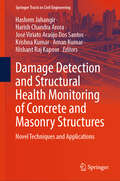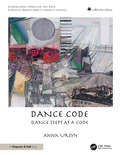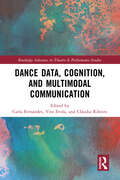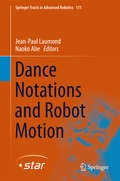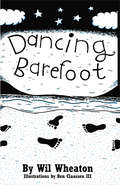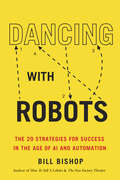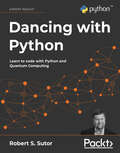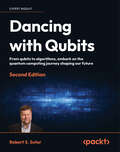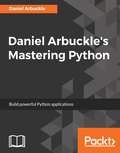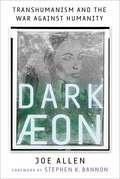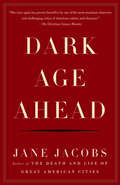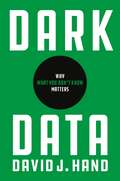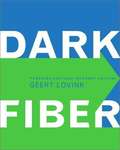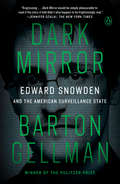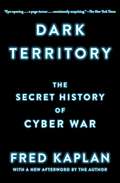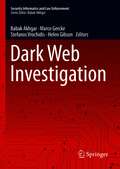- Table View
- List View
Damage Detection and Structural Health Monitoring of Concrete and Masonry Structures: Novel Techniques and Applications (Springer Tracts in Civil Engineering)
by Krishna Kumar Aman Kumar Hashem Jahangir Harish Chandra Arora José Viriato Araújo Dos Santos Nishant Raj KapoorThis book offers the use of artificial intelligence, image processing, model analysis, laser scanners, shearography, drones, contourlet, wavelet, signal processing techniques and other SHM techniques to detect the damages in the concrete as well as masonry structures. Corrosion is one major factor that causes reinforced concrete structures to deteriorate over time. However, the degrading process is not evenly distributed throughout the structure. The damage can be detected timely and the structure's degradation model can be updated with the help of proper monitoring and inspection techniques. The damages in the masonry structures may happen due to moisture ingress, cracking, mortar failure, settlement and spalling, etc. Structure health monitoring (SHM) may assist in understanding the structures deterioration mechanisms and reducing the ongoing deterioration in a scientific manner. A complete detail of both the traditional and cutting-edge approaches used in the SHM process is described in this book. The latest non-destructive techniques and semi-destructive techniques shall also be discussed in this book. This book aids academics and industry professionals with recent developments in SHM techniques. Additionally, it encourages researchers in coming up with creation of newer applications in structural engineering.
Damage and Fracture of Composite Materials and Structures (Advanced Structured Materials #17)
by Mohd Nasir TaminThis monograph presents recent research findings on fracture properties and behavior of the composites, and their damage and cracking process under both quasi-static and impact loading conditions. Theoretical treatment, experimental investigation and numerical simulation aspects of the mechanics of composites, including sandwich structures are included.
Dance Code: Dance Steps As A Code
by Anna UrsynMany people relax when coding is introduced as a language, rather than math. Even if someone creates alone, the technology involved in the process has already been developed by somebody else. Even one person's business requires professional input from others, and collaborations are often performed online. This book mixes experiences in art, coding, music, dance, choreography, video, and stage design. Dances have unique structures and so do computer codes. In both disciplines, steps are applied following patterns, and are guided by rules and restrictions. The rules obey conditions. The Dance Code script aims to make coding less feared by readers when talking with coders on the job and typing better prompts when using artificial intelligence. In this book, a dramatized, choreographed story unfolds technical information about coding and dancing.The Dance Code script tells the story of an online interaction between a coder and a prima ballerina, resulting in a shared understanding of their respective fields. An exchange between a coder and a dancer may inspire new ways to look at visually presenting knowledge through dancing, performing, or choreographed movement. Hence, the audience learns without studying.It is a part of the “Knowledge Through the Arts” series, consisting of:Dance Code - Dance Steps as a CodeNew Storytelling - Learning Through MetaphorsCode Appreciation - Reshaping KnowledgeNature Appreciation - Knowledge as Art
Dance Data, Cognition, and Multimodal Communication (Routledge Advances in Theatre & Performance Studies)
by Carla Fernandes Vito Evola Cláudia RibeiroDance Data, Cognition, and Multimodal Communication is the result of a collaborative and transdisciplinary effort towards a first definition of "dance data", with its complexities and contradictions, in a time where cognitive science is growing in parallel to the need of a renewed awareness of the body’s agency in our manyfold interactions with the world. It is a reflection on the observation of bodily movements in artistic settings, and one that views human social interactions, multimodal communication, and cognitive processes through a different lens—that of the close collaboration between performing artists, designers, and scholars. This collection focuses simultaneously on methods and technologies for creating, documenting, or representing dance data. The editors highlight works focusing on the dancers’ embodied minds, including research using neural, cognitive, behavioural, and linguistic data in the context of dance composition processes. Each chapter deals with dance data from an interdisciplinary perspective, presenting theoretical and methodological discussions emerging from empirical studies, as well as more experimental ones. The book, which includes digital Support Material on the volume's Routledge website, will be of great interest to students and scholars in contemporary dance, neuro-cognitive science, intangible cultural heritage, performing arts, cognitive linguistics, embodiment, design, new media, and creativity studies.
Dance Lexicon in Shakespeare and His Contemporaries: A Corpus Based Approach (Studies in Performance and Early Modern Drama)
by Fabio CiambellaThis book provides a thorough analysis of terpsichorean lexis in Renaissance drama. Besides considering not only the Shakespearean canon but also the Bard’s contemporaries (e.g., dramatists as John Marston and Ben Jonson among the most refined Renaissance dance aficionados), the originality of this volume is highlighted in both its methodology and structure. As far as methods of analysis are concerned, corpora such as the VEP Early Modern Drama collection and EEBO, and corpus analysis tools such as #LancsBox are used in order to offer the widest range of examples possible from early modern plays and provide co-textual references for each dance. Examples from Renaissance playwrights are fundamental for the analysis of connotative meanings of the dances listed and their performative, poetic and metaphoric role in sixteenth- and seventeenth-century drama. This study will be of great interest to Renaissance researchers, lexicographers and dance historians.
Dance Notations and Robot Motion (Springer Tracts in Advanced Robotics #111)
by Jean-Paul Laumond Naoko AbeHow and why to write a movement? Who is the writer? Who is the reader? They may be choreographers working with dancers. They may be roboticists programming robots. They may be artists designing cartoons in computer animation. In all such fields the purpose is to express an intention about a dance, a specific motion or an action to perform, in terms of intelligible sequences of elementary movements, as a music score that would be devoted to motion representation. Unfortunately there is no universal language to write a motion. Motion languages live together in a Babel tower populated by biomechanists, dance notators, neuroscientists, computer scientists, choreographers, roboticists. Each community handles its own concepts and speaks its own language. The book accounts for this diversity. Its origin is a unique workshop held at LAAS-CNRS in Toulouse in 2014. Worldwide representatives of various communities met there. Their challenge was to reach a mutual understanding allowing a choreographer to access robotics concepts, or a computer scientist to understand the subtleties of dance notation. The liveliness of this multidisciplinary meeting is reflected by the book thank to the willingness of authors to share their own experiences with others.
Dancing Barefoot
by Wil WheatonWil Wheaton--blogger, geek, and Star Trek: The Next Generation's Wesley Crusher--gives us five short-but-true tales of life in the so-called Space Age in Dancing Barefoot. With a true geek's unflinching honesty, Wil examines life, love, the web, and the absurdities of Hollywood in these compelling autobiographical narratives. Based on pieces first published in Wil's hugely popular blog, www.wilwheaton.net, the stories in Dancing Barefoot chronicle a teen TV star's journey to maturity and self-acceptance. Far from the usual celebrity tell-all, Dancing Barefoot is a vivid account of one man's version of that universal story, the search for self. If you've ever fallen in love, wondered what goes on behind the scenes at a Star Trek convention, or thought hard about the meaning of life, you'll find a kindred soul in the pages of Dancing Barefoot. In the process of uncovering his true geeky self, Wil Wheaton speaks to the inner geek in all of us. The stories: Houses in Motion - Memories fill the emptiness left within a childhood home, and saying goodbye brings them to life. Ready Or Not Here I Come - A game of hide-n-seek with the kids works as a time machine, taking Wil on a tour of the hiding and seeking of years gone by. Inferno - Two 15-year-olds pass in the night leaving behind pleasant memories and a perfumed Car Wars Deluxe Edition Box Set. We Close Our Eyes - A few beautiful moments spent dancing in the rain. The Saga of SpongeBob VegasPants - A story of love, hate, laughter and the acceptance of all things Trek.
Dancing With Robots: The 29 Strategies for Success In the Age of AI and Automation
by Bill BishopSurvive and thrive in a world being taken over by robots and other advanced technology. Artificial intelligence, machine learning, algorithms, blockchains, the Internet of Things, big data analytics, 5G networks, self-driving cars, robotics, 3D printing. In the coming years, these technologies, and others to follow, will have a profound and dramatically disruptive impact on how we work and live. Whether we like it or not, we need to develop a good working relationship with these technologies. We need to know how to “dance” with robots. In Dancing with Robots, futurist, entrepreneur, and innovation coach Bill Bishop describes 29 strategies for success in the New Economy. These new strategies represent a bold, exciting, unexpected, and radically different road map for future success.Bishop also explains how our Five Human Superpowers — embodied pattern recognition, unbridled curiosity, purpose-driven ideation, ethical framing, and metaphoric communication — give us a competitive edge over robots and other advanced technology in a world being taken over by automation and AI.
Dancing with Python: Learn Python software development from scratch and get started with quantum computing
by Robert S. SutorDevelop skills in Python by implementing exciting algorithms, including mathematical functions, classical searching, data analysis, plotting data, machine learning techniques, and quantum circuitsKey FeaturesLearn Python basics to write elegant and efficient codeCreate quantum circuits and algorithms using Qiskit and run them on quantum computing hardware and simulatorsDelve into Python's advanced features, including machine learning, analyzing data, and searchingBook DescriptionCoding is the art and engineering of creating software, and Python has been one of the core coding languages for many years. This introductory Python book helps you learn classical and quantum computing in a unified and practical way. It will help you work with numbers, strings, collections, iterators, and files. The book goes beyond functions and classes and teaches you how to use Python and Qiskit to create gates and circuits for classical and quantum computing. Learn how quantum extends classical techniques using the Grover search algorithm and the code that implements it. Dive into some advanced and widely used applications of Python and revisit strings with more sophisticated tools such as regular expressions and basic natural language processing (NLP). The final chapters introduce you to data analysis, visualizations, and supervised and unsupervised machine learning. By the end of the book, you will be proficient in classical coding and programming using the latest and most powerful quantum computers.What you will learnCreate Python code using numbers, strings, collections, classes, objects, functions, conditionals, loops, and operatorsWrite succinct code the Pythonic way using magic methods, iterators, and generatorsExplore different quantum gates and use them to build quantum circuitsAnalyze data, build basic machine learning models, and plot the resultsSearch for information using traditional methods and the quantum Grover search algorithmOptimize and test your code to run efficientlyWho this book is forThe book is for Python and coding beginners. Basic familiarity with algebra, geometry, trigonometry, and logarithms is required as the book does not cover the detailed mathematics and theory of quantum computing. You can check out the author's Dancing with Qubits book, also published by Packt, for an approachable and comprehensive introduction to quantum computing.
Dancing with Qubits: From qubits to algorithms, embark on the quantum computing journey shaping our future
by Robert S. SutorUnlock the core math and understand the technical nuances of quantum computing in this detailed guide. Delve into the practicality of NISQ algorithms, and survey promising advancements in quantum machine learning.Key FeaturesDiscover how quantum computing works and delve into the math behind it with practical examplesLearn about and assess the most up-to-date quantum computing topics including quantum machine learningExplore the inner workings of existing quantum computing technologies to understand how they may perform significantly better than their classical counterpartsBook DescriptionDancing with Qubits, Second Edition, is a comprehensive quantum computing textbook that starts with an overview of why quantum computing is so different from classical computing and describes several industry use cases where it can have a major impact. A full description of classical computing and the mathematical underpinnings of quantum computing follows, helping you better understand concepts such as superposition, entanglement, and interference. Next up are circuits and algorithms, both basic and sophisticated, as well as a survey of the physics and engineering ideas behind how quantum computing hardware is built. Finally, the book looks to the future and gives you guidance on understanding how further developments may affect you. This new edition is updated throughout with more than 100 new exercises and includes new chapters on NISQ algorithms and quantum machine learning. Understanding quantum computing requires a lot of math, and this book doesn't shy away from the necessary math concepts you'll need. Each topic is explained thoroughly and with helpful examples, leaving you with a solid foundation of knowledge in quantum computing that will help you pursue and leverage quantum-led technologies.What you will learnExplore the mathematical foundations of quantum computingDiscover the complex, mind-bending concepts that underpin quantum systemsUnderstand the key ideas behind classical and quantum computingRefresh and extend your grasp of essential mathematics, computing, and quantum theoryExamine a detailed overview of qubits and quantum circuitsDive into quantum algorithms such as Grover's search, Deutsch-Jozsa, Simon's, and Shor'sExplore the main applications of quantum computing in the fields of scientific computing, AI, and elsewhereWho this book is forDancing with Qubits, Second Edition, is a quantum computing textbook for all those who want to understand and explore the inner workings of quantum computing. This entails building up from basic to some sophisticated mathematics and is therefore best suited for those with a healthy interest in mathematics, physics, engineering, or computer science.
Danganronpa 2: Goodbye Despair Volume 1
by Spike ChunsoftHigh school student Hajime Hinata must be the "Ultimate" at something--after all, he got accepted to Hope's Peak Academy, which takes only the nation's elite teens (whether they're elite at being gangsters, gymnasts, or hamster breeders!).But he doesn't know what his special talent is...only that he and his classmates have been given a surprise summer vacation on Jabberwock Island. It may be a tropical paradise, but their sinister teddy bear headmaster Monokuma still expects them all to complete their assignments if they ever want to go home--namely, murder a fellow student and get away with it, as the survivors cross-examine each other at a classroom trial! Danganronpa 2: Goodbye Despair is an alternate version of the events told in the manga Danganronpa 2: Ultimate Luck and Hope and Despair. That series told the story through the eyes of "Ultimate Lucky Student" Nagito Komaeda; now Goodbye Despair gives you the perspective of his arch-rival in the desperate classroom murder game, Hajime Hinata!
Danganronpa 2: Goodbye Despair Volume 2
by Kuroki Q Spike ChunsoftBeautiful white sand? Check! Refreshing ocean waves? Check! Bloody body in the beach house? Check...?!Hajime and his classmates strive to overcome the despair of having now lost two classmates as they explore the buildings of the newly opened 2nd Island. Hajime learns a little about each of his classmates and the tropical paradise that is their prison. Now everyone is determined to prevent another murder from happening--everyone except Fuyuhiko Kuzuryu, that is...Danganronpa 2: Goodbye Despair is an alternate version of the events told in the manga Danganronpa 2: Ultimate Luck and Hope and Despair. That series told the story through the eyes of "Ultimate Lucky Student" Nagito Komaeda; now Goodbye Despair gives you the perspective of his arch-rival in the desperate classroom murder game, Hajime Hinata!
Danganronpa 2: Goodbye Despair Volume 3
by Kuroki QDespair is contagious...and so, it seems, is death!Fed up with the lack of bloodthirst from his captives, Monokuma has infected them with the Despair Disease, which manifests as cowardice in the mighty Owari...gullibility in the worldly Mioda...and dishonesty in the, er...in Komaeda. Afraid that they could commit murder while not in their right mind, the sick students are quarantined, keeping in touch with the "healthy" students by video monitor...only to find that despite all their precautions, the killing hasn't stopped! Danganronpa 2: Goodbye Despair is an alternate version of the events told in the manga Danganronpa 2: Ultimate Luck and Hope and Despair. That series told the story through the eyes of "Ultimate Lucky Student" Nagito Komaeda; now Goodbye Despair gives you the perspective of his arch-rival in the desperate classroom murder game, Hajime Hinata!
Danganronpa 2: Ultimate Luck and Hope and Despair Volume 1
by Kyousuke SugaThe ultimate teenage murder game continues! Based on Danganronpa 2: Goodbye Despair video game, the sequel to the original video game Danganronpa. The manga series Ultimate Luck and Hope and Despair contains bonus scenes not shown in the video game!When a new class of students at the (in)famous Hope's Peak Academy find themselves on a surprise school trip to a tropical island, they also find that suspicion and death is the only ticket home from this so-called paradise! Here, in the name of "hope," Ultimate Lucky Student Nagito Komaeda is willing to kill anybody and everybody...including himself!
Danganronpa 2: Ultimate Luck and Hope and Despair Volume 2
by Spike ChunsoftThe ultimate teenage murder game continues! Based on Danganronpa 2: Goodbye Despair, the sequel to the original Danganronpa, the manga series Ultimate Luck and Hope and Despair contains many scenes only hinted at in the game!They say if you can't stand the heat, get out of the kitchen...but the one who's on the hot seat is Ultimate Cook Teruteru Hanamura, on trial for the murder of Byakuya Togami! Revealing his true nature in the courtroom, Nagito forces his fellow students to realize they don't truly know or understand each other. It'll take all of Hajime's cunning, along with the help of his classmates, to cleave a path to the awful truth!
Danger in the Jungle Temple: An Unofficial Overworld Heroes Adventure, Book Three (Unofficial Overworld Heroes Adventure #3)
by Danica DavidsonStevie and Alex’s search for the hidden shards of the powerful Ender crystal leads them straight to the jungle biome, where they must try to find another piece of the crystal before the terrifying Ender Dragon can stop them.But when the Ender Dragon learns of their quest, she sends her army of mobs to defend the jungle temple. Can Stevie and his friends beat the spiders, zombies, and skeletons that stand between them and the Ender crystal shard? Or will the Ender Dragon reach the shard first, and be one step closer to breaking free of the End? It’s a race against the clock in this un-put-downable third book in the Unofficial Overworld Heroes Adventure series by Danica Davidson!
Daniel Arbuckle's Mastering Python
by Daniel ArbuckleGain a thorough understanding of operating in a Python development environment, and some of the most important advanced topics with Daniel Arbuckle. This dynamic, concise book is full of real-world solutions for Python 3.6 problems, and advanced-level concepts such as reactive programming, microservices, ctypes and Cython. About This Book • Covers the latest and advanced concepts of Python such as parallel processing with Python 3.6 • Explore the Python language from its basic installation and setup to concepts such as reactive programming and microservices • Get introduced to the mechanism for rewriting code in a compiled language along with ctypes and Cython tools Who This Book Is For If you are a programmer and are familiar with the basics of Python, and you want to broaden your knowledge base to develop projects better and faster, this book is for you. Even if you are not familiar with Python, Daniel Arbuckle's Mastering Python starts with the basics and takes you on a journey to become an expert in the technology. What You Will Learn • Get to grips with the basics of operating in a Python development environment • Build Python packages to efficiently create reusable code • Become proficient at creating tools and utility programs in Python • Use the Git version control system to protect your development environment from unwanted changes • Harness the power of Python to automate other software • Distribute computational tasks across multiple processors • Handle high I/O loads with asynchronous I/O to get a smoother performance • Take advantage of Python's metaprogramming and programmable syntax features • Get acquainted with the concepts behind reactive programming and RxPy In Detail Daniel Arbuckle's Mastering Python covers the basics of operating in a Python development environment, before moving on to more advanced topics. Daniel presents you with real-world solutions to Python 3.6 and advanced-level concepts, such as reactive programming, microservices, ctypes, and Cython tools. You don't need to be familiar with the Python language to use this book, as Daniel starts with a Python primer. Throughout, Daniel highlights the major aspects of managing your Python development environment, shows you how to handle parallel computation, and helps you to master asynchronous I/O with Python 3.6 to improve performance. Finally, Daniel will teach you the secrets of metaprogramming and unit testing in Python, helping you acquire the perfect skillset to be a Python expert. Daniel will get you up to speed on everything from basic programming practices to high-end tools and techniques, things that will help set you apart as a successful Python programmer. Style and Approach Daniel Arbuckle's Mastering Python covers basic to advanced-level concepts in computer science. If you are a beginner, then Daniel will help you get started. If you are experienced, he will expand your knowledge base.
Dark Aeon: Transhumanism and the War Against Humanity
by Joe AllenHumanity Is Consumed by Relentless Transformation Like a thief in the night, artificial intelligence has inserted itself into our lives. It makes important decisions for us every day. Often, we barely notice. As Joe Allen writes in this groundbreaking book, &“Transhumanism is the great merger of humankind with the Machine. At this stage in history, it consists of billions using smartphones. Going forward, we&’ll be hardwiring our brains to artificial intelligence systems.&” The world-famous robot, Sophia, symbolizes a rising techno-religion. She takes her name from the goddess—or Aeon—whose fall from grace is described in the Gnostic Gospels. With an academic background in both science and theology, Allen confronts the paradox of what he calls &“good people constructing a digital abomination.&” Dark Aeon is nothing less than a cri de coeur for humanity itself. He takes us on a roller coaster ride through history and the emergence of Scientism, and from government-mandated mRNA vaccines to the weird visions of cyborg billionaires like Elon Musk. From Silicon Valley to China, these globalists&’ visions of humanity&’s future, exposed and described in Dark Aeon, are dire and terrifying. But Joe Allen argues that humanity&’s salvation is within our grasp. Only if we refuse to avert our eyes from the impending twilight before us.
Dark Age Ahead
by Jane JacobsIn this indispensable book, urban visionary Jane Jacobs--renowned author of The Death and Life of Great American Cities and The Economy of Cities--convincingly argues that as agrarianism gives way to a technology-based future, we stand on the brink of a new dark age, a period of cultural collapse. Jacobs pinpoints five pillars of our culture that are in serious decay: community and family; higher education; the effective practice of science; taxation, and government; and the self-regulation of the learned professions. The corrosion of these pillars, Jacobs argues, is linked to societal ills such as environmental crisis, racism, and the growing gulf between rich and poor. But this is a hopeful book as well as a warning. Drawing on her vast frame of reference-from fifteenth-century Chinese shipbuilding to Ireland's cultural rebirth-Jacobs suggests how the cycles of decay can be arrested and our way of life renewed. Invigorating and accessible, Dark Age Ahead is not only the crowning achievement of Jane Jacobs' career, but one of the most important works of our time.From the Trade Paperback edition.
Dark Data: Why What You Don’t Know Matters
by David J. HandA practical guide to making good decisions in a world of missing dataIn the era of big data, it is easy to imagine that we have all the information we need to make good decisions. But in fact the data we have are never complete, and may be only the tip of the iceberg. Just as much of the universe is composed of dark matter, invisible to us but nonetheless present, the universe of information is full of dark data that we overlook at our peril. In Dark Data, data expert David Hand takes us on a fascinating and enlightening journey into the world of the data we don't see.Dark Data explores the many ways in which we can be blind to missing data and how that can lead us to conclusions and actions that are mistaken, dangerous, or even disastrous. Examining a wealth of real-life examples, from the Challenger shuttle explosion to complex financial frauds, Hand gives us a practical taxonomy of the types of dark data that exist and the situations in which they can arise, so that we can learn to recognize and control for them. In doing so, he teaches us not only to be alert to the problems presented by the things we don’t know, but also shows how dark data can be used to our advantage, leading to greater understanding and better decisions.Today, we all make decisions using data. Dark Data shows us all how to reduce the risk of making bad ones.
Dark Fiber: Tracking Critical Internet Culture
by Geert LovinkAccording to media critic Geert Lovink, the Internet is being closed off by corporations and governments intent on creating a business and information environment free of dissent. Calling himself a radical media pragmatist, Lovink envisions an Internet culture that goes beyond the engineering culture that spawned it to bring humanities, user groups, social movements, nongovernmental organizations (NGOs), artists, and cultural critics into the core of Internet development. In Dark Fiber, Lovink combines aesthetic and ethical concerns and issues of navigation and usability without ever losing sight of the cultural and economic agendas of those who control hardware, software, content, design, and delivery. He examines the unwarranted faith of the cyber-libertarians in the ability of market forces to create a decentralized, accessible communication system. He studies the inner dynamics of hackers' groups, Internet activists, and artists, seeking to understand the social laws of online life. Finally, he calls for the injection of political and economic competence into the community of freedom-loving cyber-citizens, to wrest the Internet from corporate and state control. The topics include the erosion of email, bandwidth for all, the rise and fall of dot-com mania, techno-mysticism, sustainable social networks, the fight for a public Internet time standard, the strategies of Internet activists, mailing list culture, and collaborative text filtering. Stressing the importance of intercultural collaboration, Lovink includes reports from Albania, where NGOs and artists use new media to combat the country's poverty and isolation; from Taiwan, where the September 1999 earthquake highlighted the cultural politics of the Internet; and from Delhi, where a new media center explores free software, public access, and Hindi interfaces.
Dark Mirror: Edward Snowden and the American Surveillance State
by Barton GellmanFrom the three-time Pulitzer Prize-winning author of the New York Times bestseller Angler, who unearthed the deepest secrets of Edward Snowden's NSA archive, the first master narrative of the surveillance state that emerged after 9/11 and why it matters, based on scores of hours of conversation with Snowden and groundbreaking reportage in Washington, London, Moscow and Silicon ValleyEdward Snowden chose three journalists to tell the stories in his Top Secret trove of NSA documents: Barton Gellman of The Washington Post, Glenn Greenwald of The Guardian and filmmaker Laura Poitras, all of whom would share the Pulitzer Prize for Public Service. Poitras went on to direct the Oscar-winning Citizen Four. Greenwald wrote an instant memoir and cast himself as a pugilist on Snowden's behalf.Barton Gellman took his own path. Snowden and his documents were the beginning, not the end, of a story he had prepared his whole life to tell. More than 20 years as a top investigative journalist armed him with deep sources in national security and high technology. New sources reached out from government and industry, making contact on the same kinds of secret, anonymous channels that Snowden used. Gellman's old reporting notes unlocked new puzzles in the NSA archive. Long days and evenings with Snowden in Moscow revealed a complex character who fit none of the stock images imposed on him by others.Gellman now brings his unique access and storytelling gifts to a true-life spy tale that touches us all. Snowden captured the public imagination but left millions of people unsure what to think. Who is the man, really? How did he beat the world's most advanced surveillance agency at its own game? Is government and corporate spying as bad as he says?Dark Mirror is the master narrative we have waited for, told with authority and an inside view of extraordinary events. Within it is a personal account of the obstacles facing the author, beginning with Gellman's discovery of his own name in the NSA document trove. Google notifies him that a foreign government is trying to compromise his account. A trusted technical adviser finds anomalies on his laptop. Sophisticated impostors approach Gellman with counterfeit documents, attempting to divert or discredit his work. Throughout Dark Mirror, the author describes an escalating battle against unknown digital adversaries, forcing him to mimic their tradecraft in self-defense.Written in the vivid scenes and insights that marked Gellman's bestselling Angler, Dark Mirror is an inside account of the surveillance-industrial revolution and its discontents, fighting back against state and corporate intrusions into our most private spheres. Along the way it tells the story of a government leak unrivaled in drama since All the President's Men.
Dark Parts of the Universe
by Samuel MillerOuter Banks meets Bone Gap in New York Times bestselling author Samuel Miller’s propulsive and genre-bending YA mystery, following a group of teenagers who discover a dead body while playing an app-based adventure game that sends players to “random” locations, unlocking a much deeper mystery about their small town. In Calico Springs, Willie’s life has been defined by two powerful forces: God and the river. The “miracle boy” died for five minutes as a young child, and ever since, Willie is certain he survived for a reason, but that purpose didn’t become clear until he found the Game.The Game is called Manifest Atlas, and the concept is simple: enter an intention and the Game provides a target—a blinking blue dot on the map. Willie’s second time playing Manifest Atlas, his intention takes him to an ominous target: three empty graves. Willie is sure the Game is telling him he’s going to die.Willie’s older brother, Bones, doesn’t believe him, but their friends are intrigued. Sarai, a girl from across the river, sets the next intention: something bloody. The group follows the Game’s coordinates and they discover something even more unsettling than the graves: a dead body. Sarai’s stepfather’s body. The Game is suddenly personal.Willie is dedicated to proving the Game works while Sarai is set on finding out what happened to her stepdad. Bones just wants to enjoy his last summer before real life begins. As the group digs deeper into Manifest Atlas, stranger and wilder things begin to appear, unlocking a much deeper mystery running like an undercurrent through the small town.
Dark Territory: The Secret History of Cyber War
by Fred Kaplan&“An important, disturbing, and gripping history&” (Kirkus Reviews, starred review), the never-before-told story of the computer scientists and the NSA, Pentagon, and White House policymakers who invent and employ cyber wars—where every country can be a major power player and every hacker a mass destroyer.In June 1983, President Reagan watched the movie War Games, in which a teenager unwittingly hacks the Pentagon, and asked his top general if the scenario was plausible. The general said it was. This set in motion the first presidential directive on computer security. From the 1991 Gulf War to conflicts in Haiti, Serbia, Syria, the former Soviet republics, Iraq, and Iran, where cyber warfare played a significant role, Dark Territory chronicles a little-known past that shines an unsettling light on our future. Fred Kaplan probes the inner corridors of the National Security Agency, the beyond-top-secret cyber units in the Pentagon, the “information warfare” squads of the military services, and the national security debates in the White House to reveal the details of the officers, policymakers, scientists, and spies who devised this new form of warfare and who have been planning—and (more often than people know) fighting—these wars for decades. “An eye-opening history of our government’s efforts to effectively manage our national security in the face of the largely open global communications network established by the World Wide Web….Dark Territory is a page-turner [and] consistently surprising” (The New York Times).
Dark Web Investigation (Security Informatics and Law Enforcement)
by Helen Gibson Babak Akhgar Stefanos Vrochidis Marco GerckeThis edited volume explores the fundamental aspects of the dark web, ranging from the technologies that power it, the cryptocurrencies that drive its markets, the criminalities it facilitates to the methods that investigators can employ to master it as a strand of open source intelligence. The book provides readers with detailed theoretical, technical and practical knowledge including the application of legal frameworks. With this it offers crucial insights for practitioners as well as academics into the multidisciplinary nature of dark web investigations for the identification and interception of illegal content and activities addressing both theoretical and practical issues.
